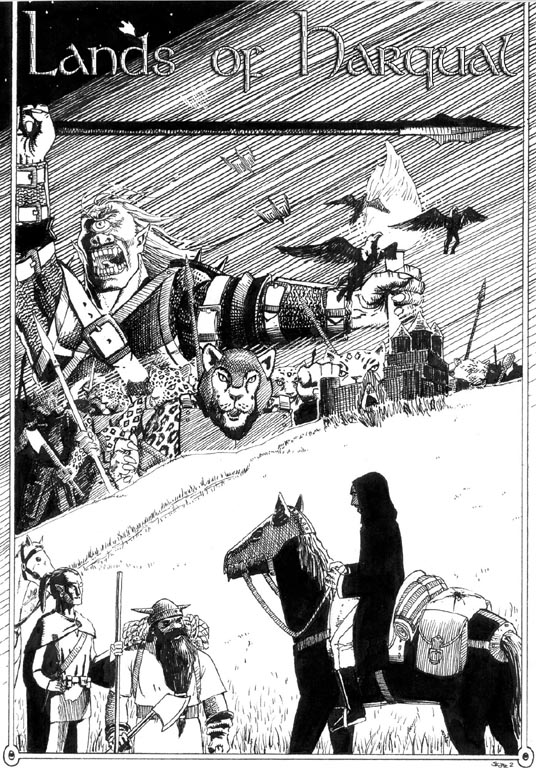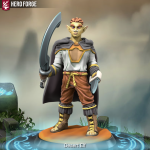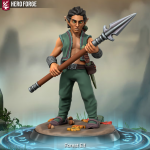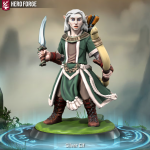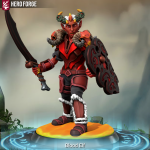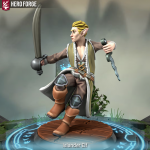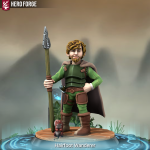THE DWARVES OF HARQUAL
There are three major races of dwarves known throughout the Lands of Harqual: high dwarves, hill dwarves, and the Torin.
HIGH DWARF
High dwarves are taller than their hill dwarven cousins, averaging 4-½ feet in height and 150 pounds. Their skin and hair are generally ruddier than hill dwarves and they tend to wear their heavy beards down past their stomachs. High dwarven eye color tends to range from the color of the earth to the sparkling gems that can be found within. High dwarves prefer warm, functional garments, which tend to be black, brown, or light gray in color.
The high dwarves of Harqual are becoming a forgotten race as they struggle to survive in the isolated mountain ranges of Northern Harqual. High dwarves are almost never encountered beyond their mountain homes and rarely will they trust non-dwarves. One of the oldest dwarven races on Harqual in ages past, high dwarves exist in almost every mountain range of the North. They are one of the few native races to Harqual.
Since the destruction of the Dwarven City of Highstone — by foul magic and the betrayal of their people by one of their own to the Opposition — these dwarves have had little refuge from their enemies. Forced to live on the highest peaks, high dwarves have become used to being isolated for long periods of time without aid from their hill dwarven cousins. This hasn’t stopped them from petitioning to be allowed to enter and to live in Milo, the Capital City of the Kingdom of the Greystones.
The High Thane, Sannl Blackforge, has so far refused to let the high dwarven refugees enter the city fearing that doing so would risk the Opposition turning their attention upon the capital city. This has been a hard decision for her to live with as she is a high dwarf herself and has kin amongst the homeless high dwarven clans. However, this decision had been her father’s — the previous High Thane — before he died, and she doesn’t want to go against his wishes.
As a result, many high dwarven clans have left the Greystone Mountains entirely. Several clans have moved farther north to avoid the machinations of the Opposition and the evil humanoids that have taken advantage of the high dwarves' plight. Many of these clans can now be found in the Aragar Mountains and the Kaltar Mountains in the farthest reaches of the Northlands. However, one clan is rumored to have moved south and entered the Sunus Mountains in search of the lost Dwarven City of Nithardel and reclaim it for the dwarven people.
High Dwarf Traits
High dwarf characters benefit from a number of racial traits:
- +2 to Constitution, +2 to Wisdom, -4 to Charisma. The high dwarves of Harqual are more withdrawn then their hill dwarven cousins, but they make up for this by being more intuitive.
- High dwarf base land speed is 20 feet. However, high dwarves can move at this speed even when wearing medium or heavy armor or when carrying a medium or heavy load.
- Darkvision out to 60 feet.
- Stonecunning: This ability grants a high dwarf a +2 racial bonus on Search checks to notice unusual stonework, such as sliding walls, stonework traps, new construction (even when built to match the old), unsafe stone surfaces, shaky stone ceilings, and the like. Something that isn't stone but that is disguised as stone also counts as unusual stonework. A high dwarf who merely comes within 10 feet of unusual stonework can make a Search check as if he were actively searching, and a high dwarf can use the Search skill to find stonework traps as a rogue can. A high dwarf can also intuit depth, sensing his approximate depth underground as naturally as a human can sense which way is up. High dwarves have a sixth sense about stonework, an innate ability that they get plenty of opportunity to practice and hone in their underground homes.
- Weapon Familiarity: High dwarves treat dwarven waraxes and dwarven urgroshes as martial weapons, rather than exotic weapons.
- Stability: High dwarves are exceptionally stable on their feet. A high dwarf has a +4 bonus on ability checks made to resist being bull rushed or tripped when standing on the ground (but not when climbing, flying, riding, or otherwise not standing firmly on the ground).
- +2 racial bonus on saving throws against poison.
- +2 racial bonus on saving throws against spells and spell-like effects.
- +1 racial bonus on attack rolls against known members of the Opposition: Since the destruction of Highstone it has become every high dwarf's goal to seek vengeance against the evil, secretive organization known as the Opposition. Note: Player’s have the option to select the hill dwarf +1 racial bonus on attack rolls against gnolls and ogres.
- +4 dodge bonus to Armor Class against creatures of the giant type (such as ogres, trolls, and hill giants).
- +2 racial bonus on Appraise checks that are related to stone or metal items.
- +2 racial bonus on Craft checks that are related to stone or metal.
- Automatic Languages: Dwarven and Undercommon. Bonus Languages: Elven, Giant, Goblin, Orc, and Terran.
- Favored Class: Cleric. A multiclass high dwarf's cleric class does not count when determining whether he suffers an XP penalty for multiclassing.
- Level Adjustment +0.
HILL DWARF
Hill dwarves have all the physical characteristics of the dwarves listed in the D&D Player's Handbook v.3.5 including height, weight, hair, skin and eye color, and type of dress. They are more likely to braid their beards than high dwarves. Unlike high dwarves, hill dwarves are not native to the Lands of Harqual and most believe they immigrated to the continent a frozen land bridge from another continent (i.e. Kanpur). However, some hill dwarven sages believe that their race came from another world entirely; they believe that the hill dwarves immigrated to Kulan using huge spelljamming citadels.
Regardless of how they arrived on Harqual, hill dwarves have existed in the mountain ranges of Northern Harqual since their race first arrived on the continent, during the time when the North Gods still lived amongst the barbarians of the Northlands. Their patron god, Moradin, is an honored member and friend to the Pantheon of the North. As a result, hill dwarves and the barbarians of the Northlands generally get along with each other and trade goods regularly.
The destruction of the Dwarven City of Highstone left a handful of hill dwarven clans homeless; they are now scattered around the hills and mountains near the Dwarven City of Milo. The current High Thane of the Greystones, Sannl Blackforge, has so far refused to allow these hill dwarven clans to permanently take up residence in Milo as her advisors fear overcrowding. This was the ruling of her father before he was killed, and she wants to honor his wishes.
However, as a result, many of these homeless hill dwarves are leaving their ancestral home for the human lands of the Eastern Shores and the western lands near the Mines of Morhan as well as the Northlands. A large number of these dwarves have taken up residence in the hills surrounding the Sunus Mountains, and it is rumored that those migrating west may petitioning the Bitran in the Rilous Mountains for sanctuary.
Hill dwarves can be found almost anywhere North of the Great Expanse as many of their kind have left the Greystone Mountains in the past. They can be found living in the Kul Moren Mountains and in the lands of many human-dominated lands. Many of these dwarven refugees lose their traditions over time and become “sundered.” (See under “Other Variant Dwarf Cultures on Harqual” for more details on sundered dwarves.)
Hill Dwarf Traits
Hill dwarf characters benefit from a number of racial traits:
- +2 to Constitution, -2 to Charisma.
- Hill dwarf base land speed is 20 feet. However, hill dwarves can move at this speed even when wearing medium or heavy armor or when carrying a medium or heavy load.
- Darkvision out to 60 feet.
- Stonecunning: This ability grants a hill dwarf a +2 racial bonus on Search checks to notice unusual stonework, such as sliding walls, stonework traps, new construction (even when built to match the old), unsafe stone surfaces, shaky stone ceilings, and the like. Something that isn't stone but that is disguised as stone also counts as unusual stonework. A hill dwarf who merely comes within 10 feet of unusual stonework can make a Search check as if he were actively searching, and a hill dwarf can use the Search skill to find stonework traps as a rogue can. A hill dwarf can also intuit depth, sensing his approximate depth underground as naturally as a human can sense which way is up. Hill dwarves have a sixth sense about stonework, an innate ability that they get plenty of opportunity to practice and hone in their underground homes.
- Weapon Familiarity: Hill dwarves treat dwarven waraxes and dwarven urgroshes as martial weapons, rather than exotic weapons.
- Stability: Hill dwarves are exceptionally stable on their feet. A hill dwarf has a +4 bonus on ability checks made to resist being bull rushed or tripped when standing on the ground (but not when climbing, flying, riding, or otherwise not standing firmly on the ground).
- +2 racial bonus on saving throws against poison.
- +2 racial bonus on saving throws against spells and spell-like effects.
- +1 racial bonus to hit gnolls and ogres. Hill dwarves are trained in the special combat techniques that allow them to fight their common enemies more effectively.
- +4 dodge bonus to Armor Class against creatures of the giant type (such as ogres, trolls, and hill giants).
- +2 racial bonus on Appraise checks that are related to stone or metal items.
- +2 racial bonus on Craft checks that are related to stone or metal.
- Automatic Languages: Dwarven and Common. Bonus Languages: Barbarian, Giant, Goblin, Orc, Terran, and Undercommon.
- Favored Class: Fighter. A multiclass hill dwarf's fighter class does not count when determining whether he suffers an XP penalty for multiclassing.
- Level Adjustment +0.
THE TORIN
The Torin are an offshoot race from a clan of dwarves that abandoned the Dwarven City of Nithardel in the Sunus Mountains over three hundred years ago. The reason for this has been lost to time, and the Torin refuse to discuss the matter and no one has been able to locate the lost dwarven city since.
After the Torin abandoned their homeland they immigrated south, past the Great Expanse, and many now live a nomadic lifestyle throughout the savannas of the Far South hunting antelope and zebras from the back of dire badgers. Not all Torin were content to give up their roots completely, however, and many have begun to try and rekindle the past by moving back into hills and mountains of the southern lands.
The most notable of these communities are the cities of Thunderwall and Highwall, which are located high above the eastern hills of the Heverkent Forest. Thunderwall is located in a great meteor crater, while Highwall is located south of that location on a high plateau. The two cities are dominated by the Torin but are also home to many Rockwood gnomes and southern elves.
Regardless of traditions, the Torin try to get along with just about everyone. Most other races view the Torin as strange and savage but will trade with them for their fine weapons and jewelry. The only true enemies the Torin have are the zebranaurs as that race takes exception to the dwarves' diet of zebra meat.
Torin are just as intelligent as their northern cousins, but they are often looked down upon by northern dwarves, regardless. They have light brown to russet colored hair and are fond of drooping mustaches and short braided ponytails. Torin males don't grow beards as The Far South is hot enough as it is, and females do not have any facial hair at all. They have brown or olive skin tones, and they always have brown or black eyes.
Torin Dwarf Traits
Torin dwarf characters benefit from a number of racial traits:
- +2 to Dexterity, +2 to Constitution, -2 to Charisma. Torin are quick with a bow and can handle the noon day sun of the savannas without any difficulty. However, their wild-like appearance and behavior tends to set them apart from other races.
- Torin dwarf base land speed is 20 feet. However, Torin dwarves can move at this speed even when wearing medium or heavy armor or when carrying a medium or heavy load.
- Low-light Vision. Torin dwarves can see twice as far as a human can in starlight, moonlight, torchlight, and similar conditions of poor illumination.
- Claustrophobia: Torin dwarves are claustrophobic. They must roll a successful Will save in order to overcome their fear of the underground before entering dungeons, caves, and tombs. If the check fails, the PC may not enter. Once underground he must make save each day. If he fails, he will want to leave the underground by the most direct route. Underground, a Torin dwarf attacks with a -1 penalty to his rolls. Should he fail his claustrophobic saving throw, the penalty increases by -1 for each additional day he stays underground. If he fails to reach open air, he may attempt further saving throws each day to overcome his claustrophobia. These saving throws are made at the same penalty as the dwarf's current attack roll penalty.
- Weapon Familiarity: Torin dwarves treat dwarven waraxes and dwarven urgroshes as martial weapons, rather than exotic weapons.
- Stability: Torin dwarves are exceptionally stable on their feet. A Torin dwarf has a +4 bonus on ability checks made to resist being bull rushed or tripped when standing on the ground (but not when climbing, flying, riding, or otherwise not standing firmly on the ground).
- +2 racial bonus on saving throws against poison.
- +2 racial bonus on saving throws against spells and spell-like effects.
- +1 racial bonus to attack rolls against ogres. This bonus is due to years of being trained to defend against this race more effectively.
- +1 racial bonus to attack and damage rolls with all ranged weapons (including crossbows).
- +4 dodge bonus to Armor Class against creatures of the giant type (such as ogres, trolls, and hill giants).
- +2 racial bonus on Craft checks related to wood, precious metals, and gems.
- Automatic Languages: Dwarven (Torin-dialect) and Suar. Bonus Languages: Dwarven, Giant, Gnome, Halfling, and Rakasta.
- Favored Class: Barbarian. A multiclass Torin dwarf's barbarian class does not count when determining whether he suffers an XP penalty for multiclassing.
- Level Adjustment +1.
MINOR DWARVEN RACES
In addition to the major races listed above there are two notable, minor races of dwarves — Bitran dwarves and the duergar — as well as two fairly unknown, minor races of dwarves — the dwarves of the Badlands and Gletscher dwarves.
Bitran Dwarves
The word “Bitran” is the collective name given to the dwarves and gnomes that were brought to Kulan from the world known as Maran (my Dark World campaign setting). While these newcomers to Kulan are distinctively two different races, they are considered, in fact, one people regardless of race.
The Bitran come from an underground city in the Rilous Mountains, which is simply called the City of Bitran. It is a strange place to outsiders filled with strange magical gadgets and weaponry. The Bitran have knowledge in something they call Black Thunder (similar to the smokepowder made in the Ferinmal Homeland). This substance is nearly unheard of beyond the borders of the Kingdom of Ahamudia. (The Bitran do not created hand-held firearms, but they do have cannons protecting the City of Bitran.)
Both races are distinctive in appearance from the native dwarven and gnomish races of Harqual in that their skin is either burnished bronze to pitch black in color. Their hair is always fiery red in color and their eyes are as black as coal. Some believe they have been infused with the very magic that courses through their forges. The Bitran wear tough leather garments with studded iron rivets embedded on the outside (masterwork studded leather armor.)
The dwarves of Bitran were transported to Kulan during the Transformation. Cutoff from their previous world, they have been tested by the evil of the Empire of Swords and endured the lost of clan members not duplicated by the mysterious magical event. Bitran dwarves live amongst their gnome cousins and the two races are considered equals. (The King of Bitran is a gnome.) They tend to be more curious and outgoing than the native dwarven races of Harqual.
Bitran dwarves have the touch of magic in them. They can just as easily become sorcerers as they can become fighters, rogues, or any other class except wizards. For some strange reason, Bitran dwarves can never learn traditional magic. It would be like asking them to fly without having wings.
Bitran Dwarf Traits
Bitran dwarf characters benefit from a number of racial traits:
- +2 to Constitution, -2 to Intelligence, +2 to Charisma. Bitran dwarves are both robust and compelling, but are not as knowledgeable as other dwarves.
- Bitran dwarves aren’t native to the World of Kulan; therefore, they have the Extraplanar Subtype.
- Medium-size. As Medium creatures, Bitran dwarves have no special bonuses or penalties due to their size.
Bitran dwarf base land speed is 20 feet. However, dwarves can move at this speed even when wearing medium or heavy armor or when carrying a medium or heavy load (unlike other creatures, whose speed is reduced in such situations).
- Bitran dwarves can see in the dark up to 60 feet.
- Weapon Familiarity: Bitran dwarves may treat dwarven waraxes and dwarven urgroshes as martial weapons, rather than exotic weapons.
- Stability: A Bitran dwarf gains a +4 bonus on ability checks made to resist being bull rushed or tripped when standing on the ground (but not when climbing, flying, riding, or otherwise not standing firmly on the ground).
- +2 racial bonus on saving throws against poison.
- +2 racial bonus on saving throws against spells and spell-like effects.
- +1 racial bonus on attack rolls against orcs and goblinoids.
- +4 dodge bonus to Armor Class against monsters of the giant type. Any time a Bitran dwarf loses its Dexterity bonus (if any) to Armor Class, such as when it's caught flat-footed, it loses its dodge bonus, too.
- Bitran dwarves only have a +1 racial bonus to Appraise and Craft checks. They are also less familiar with unusual stonework, gaining only a +1 racial bonus for their Stonecunning ability. (See the D&D Player’s Handbook v.3.5 for details on Stonecunning.)
- Bitran dwarf sorcerers can cast all of the spells listed as part of the Earth Domain, as regular sorcerer spells of the corresponding Earth level listed for each spell. The Bitran dwarf sorcerer doesn’t gain the domain granted power, however.
- Endure (Su): A Bitran dwarf is permanently affected as if a resistance orison had been cast upon the character. (This replaces the +2 racial bonus against spells and spell-like effects.)
- Automatic Languages: Bitran. Bonus Languages: Aphranæn, Goblin (Maran), Javeldian, Orc (Maran) and Vananean. Bitran dwarves haven't been exposed to the cultures of Harqual for very long and, thus, have a limited number of obscure Maran languages to choose from.
- Favored Class: Players may choose either the Fighter or Sorcerer class as their Bitran dwarf's favored class. Once the player has made this choice the decision cannot be changed. A multiclass Bitran dwarf's favored class does not count when determining whether he suffers an XP penalty for multiclassing.
- Level Adjustment: +1.
The Duergar (Expanded Psionics Handbook)
The duergar of Kulan are nearly identical to the duergar of other worlds. Their appearance and alignment tendencies are the same for the most part. However, what is different is their history and society. In ages past, before Cronn walked from the mists into the Northlands of Harqual, a great war in the Underearth was nearing its end. This conflict, known as the the Underearth War, raged throughout Kulan's Underearth for centuries. Brought about by the arrival of a dark-skinned race of elves known as drow, the conflict grew from the region of the Underearth near what is now Bluffside (on the surface.) The drow arrived through magical gates from an alternate Prime Material Plane and began to settle and conquer the other races of the Underearth.
The drow came in the hundreds of thousands and the other races found that banding together was their only chance for survival. Thus, it was the duergar, morlocks, earth ogres, and dozens of other dark races that pushed back the drow onslaught and destroyed the gates that had brought the drow to Kulan. The allied races viciously hunted down every drow, no matter how far the dark elves fled. Only a small number survived by ascending to the surface near Bluffside, but after centuries of dilution with the high elves of the region only a half-drow half-high elf cross remains known as the Nevae. Beyond the region of Bluffside, the the drow passed into obscurity.
However, the Underearth War didn't end there. Morlocks reproduce faster than jackrabbits, and they knew they had the advantage. They turned on their allies after the last of the drow were wiped out. This included the duergar who had tried to warn the other races of the morlocks' intentions. Their warnings fell on deaf ears, and the morlocks began exterminating entire races from the Underearth. The morlocks turned out to be more dangerous than the drow ever were.
The duergar found themselves hard pressed even with their foresight to see the morlocks' treachery and prepare for it. It is this fact that kept the bulk of their race from being enslaved or exterminated. The last remaining clans of the duergar retreated from the morlock onslaught; they retreated to the other side of the world. They found the deep delves under the continent of Harqual to their liking and proceeded to build new cities in the great delves. They spent years preparing for the morlocks to come and come they did. The Duergar-Morlock War lasted for centuries, and the duergar were hard pressed by the morlock onslaught once again.
Several delves fell to the morlocks forcing some of the duergar to do what they never thought they would have to do to survive. They began ascending to the surface. This brought them into conflict with the other dwarven races of Harqual, so the duergar made a pact with the mountain orcs of the Kul Moren Mountains and Thunder Mountains. The duergar would aid the mountain orcs in their quest to conquer the surface world in exchange for mutual defense from the morlocks. The arrangement has worked out well for both races; although, the arrangement often leads to disagreements between the two races.
Note, however, that not all of the duergar that ascended to the surface met resistance. Several clans ascended into the upper caverns of the Grey Mountains on Teverroot Island. (The mountains didn't have a name before the duergar settled there.) The volcanically active mountain range was isolated enough for the duergar clans to avoid the notice of the morlocks. Two great duergar cities — Duroko and Durgan — were initially dug into and up through the stone of the Gray Mountains. In recent years the duergar have built another, which is called Serugar. These duergar call their mountainous home Duergold.
Thus, the Gray Mountains are completely dominated by the duergar, and they live in an uneasy peace with the citizens of the Dark Kingdom of the Jealous Arcane (These followers of Xuar dominate the rest of the island.). However, this peace is due more to the threat of the morlocks to both kingdoms, than to any mutual entreaty towards each other. The gray dwarves of Duergold dream of a day when they can destroy the morlocks and spread their kingdom back into the depths of the Underearth.
Meanwhile, in the great delves below Harqual, The Duergar-Morlock War has turned into a cold war. Tensions are high and secret skirmishes have broken out. Yet, there has been little true conflict for the last 300 years. The duergar believe it is only a matter of time until the morlocks again push to conquer the last of the duergar delves. After that they could threaten all of Harqual as well, and while the duergar have little love for the surface-dwellers, they are the only thing that prevents this from happening.
The duergar of Harqual have the same racial traits as listed in the D&D Expanded Psionics Handbook.
Dwarves of the Badlands (Sandstorm)
This minor race of dwarves is also known as the Ferinmal, which is also the name of the region that they live in, exclusively. It is though that they are related to the Torin in some manner but no proof of this has been found. They are well adapted to the harsh conditions of the Hills of Ferinmal and the rugged badlands surrounding them.
Badlands dwarves have a knack for creating and using flintlocks and other smokepowder firearms, which they usually sell to outsiders at inflated rates. They also have a knack for digging through the rough hills for water sources that others would be hard pressed to locate. Individual clans have been known too make a fortune selling water to travelers such as trade caravans and the nomadic desert elves. Badlands dwarves tend to keep to themselves, but they do get along well enough with the Torin, desert elves, and the other citizens of The Ferinmal Homeland.
Dwarf of the Badlands Traits
The badlands dwarves of the Ferinmal Homeland have the same racial traits as noted for Badlands dwarves listed in D&D Sandstorm: Mastering the Perils of Fire and Sand, with the following change:
- Weapon Familiarity: Badlands dwarves treat all flintlock firearms as martial weapons, rather than exotic weapons.
Gletscher Dwarves (Frostburn)
A minor and previously unknown sub-race of dwarf is slowly becoming known in the far reaches of the Northlands. These dwarves, known as the Gletscher, or glacier dwarves, have recently been spotted in the northern reaches of cold mountain ranges throughout the regions of Desinon Forest and the Lands of the Nashee. They haven’t been spotted in the Kaltar Mountains as of yet.
Those who have heard of the Gletscher believe that they have only recently migrated to Harqual from lands beyond the Northlands across the frozen ice of the North Sea. The truth is that Gletscher are a race that originated in the Sunless Land, the Godly Realm of Cronn, Father of the North Gods. The Gletscher were sent to Cronn’s realm from Moradin, The Soul Forger, as a sign of solidarity between the North Gods and Dwarven Gods.
Gletscher dwarves have great respect for both Moradin and Cronn but tend to worship the Dwarven Gods almost exclusively. A few of the more chaotically-inclined individuals do worship Cronn, however. Other deities that a Gletscher dwarf PC might worship include Halmyr, Jalivier, Lokun (rare), and Uller (very rare). A few clans of Gletscher live within the confines of the Sky Traveler’s Godly Realm of Hougard and are chaotic good in alignment.
The Gletscher dwarves of Harqual have the same racial traits as noted for Glacier dwarves listed in D&D Frostburn: Mastering the Perils of Ice and Snow.
Other Variant Dwarf Cultures on Harqual
There are few other distinct cultures of dwarves on Harqual. The first two are based on dwarven races brought to the continent during the time of The Transformation while the other two refer to native dwarven sub-cultures of Harqual.
Dwarves of Korvosa
Besides humans, the most populace race in the City-state of Korvosa is dwarven. Specifically, the race of Korvosan dwarves known as the Janderhoff. This name refers to a dwarven city on the home world of the Korvosans, which was not duplicated on Harqual during the time of The Transformation. This has forced the dwarves living in Korvosa to adapt. On their home world, the dwarves of Janderhoff were relied on to provide the city with the black marble so prized in Korvosa. Now, without this resource, the dwarves have had to become proactive in finding iron, silver and stone for the city-state, and without the aid of their lost kin, they are having a tough time supplying demand.
The fact that the rockwood gnomes of the Hinderfall Mountains constantly block their attempts to mine in the mountain range hasn't helped matters either. “Korvosan” dwarves are arrested on sight within the Realm of the Little Trees or killed outright within the Inner Forest of the Heverkent. The denizens of the Outer Forest are a little more tolerant towards the Janderhoff, and many of the shadier denizens will sell gems and precious metals to them; although, they always charge Janderhoff dwarves exorbitant sums of gold for any type of goods. More often the Janderhoff must trade with the citizens of the distant city of Rhamsandron or the Domain of Fallen Trees, which has increased tensions even more between Korvosa and its other new neighbors.
The Janderhoff have roughly the same appearance as the northern dwarves of the continent. They are easy to distinguish from the Torin (whom they dislike) as they never shave their beards; although, they are known for keeping their beards trimmed short, especially in the hotter months of the year. The Janderhoff have the same racial traits as the Dwarf entry in the D&D PHB v.3.5; however, they have a slightly different set of Automatic and Bonus Languages as per the following changes: Automatic Languages – remove Common, add Taldane; Bonus Languages: add Suar. The Dwarven language of their home world is close enough to the Dwarven language of Harqual that they can understand Harqualian dwarves without any real difficulty. Note that theres is a growing movement amongst the Janderhoff dwarves to modify their racial language to distinguish themselves from the other dwarven races of Harqual.
Janderhoff dwarves, as a race, are not native to the World of Kulan; therefore, they have the Extraplanar subtype. However, a Janderhoff dwarf that is born in the Lands of Harqual is considered to be native to the World of Kulan, but a native Janderhoff dwarf would still be considered an infant at this time.
Dwarves of the Tyrian Valley
Humans from the Chara Coast have been known to mistake this unique race of dwarves for the Torin. However, once a Tyrian dwarf speaks there is little doubt that he or she isn't a Torin dwarf. Dwarves of the Tyrian Valley are another Transformation race brought to the World of Kulan from another world – a world the Tyrian races call Athas. This world seems to have its own unique versions of the various civilized races of Harqual including not only dwarves but elves, halflings, and humans as well.
The Tyrian Valley sits on the eastern side of the Patron Mountains within the boundaries of the Great Expanse. It has come to influence not only the desert elves of the Expanse but also the cities of the Chara Coast. It is the dwarves of the Tyrian Valley that influences the latter. Citizens of the Chara Cities often call Tyrian dwarves the Steadfast when praising them and the Unyielding when belittling them. Tyrian dwarves often outwork even the stoutest hill dwarf or Torin dwarf and once they put their mind to a task they don't stop until it's finished.
Tyrian dwarves have all the racial traits of the Dwarf entry in Chapter 2: Races in the Dark Sun 3 PDF document, which can be downloaded from the Dark Sun Fan Website, The Burnt World of Athas.
Tyrian dwarves, as a race, are not native to the World of Kulan; therefore, they have the Extraplanar subtype. However, a Tyrian dwarf that is born in the Lands of Harqual is considered to be native to the World of Kulan, but a native Tyrian dwarf would still be considered a child at this time.
Seacliff Dwarves (Stormwrack)
Seacliff dwarves are a rare subculture of dwarves on Harqual. Often called “salt beards” by Torin dwarves, these dwarves live in the tall, impregnable cliffs of the Stonegard Holds that overlook the Hallian Sea and the Strait of the Whispering Stones on the island group known as the Rumbling Archipelago just off the coast of the Nebral Peninsula.
These dwarves have lived here since before the Divinity War ended 1,001 years ago, and they do not worship the traditional Dwarven Deities. Instead, they venerate the Dwarven Gods known as Era, Granok, and Orbane as well as several Interloper and World Gods including Ahto, Aoskar, Calphas, Ibrandul, Kord, Ptah, Ulaa, and Velit. Seacliff dwarves are more fun loving and jovial than other dwarves, and they are excellent seafarers and sky captains.
The Seacliff dwarves of Harqual have the same racial traits as noted for Seacliff dwarves listed in D&D Stormwrack: Mastering the Perils of Wind and Wave.
Sundered Dwarves
Over the years, many dwarves have found themselves cut off from the various kingdoms of the dwarves. Without a land to call their own, many of these “sundered” dwarves would eventually come to live in human-dominated cities. They adapted to life in these cities as best they could building strong foundations of stone-homes above ground. The best examples of this are in the Lands of the Cities of the Wind just southeast of the Greystone Mountains. The city of Ciros is known for its extensive population of sundered dwarves. Sundered dwarves are exactly like hill dwarves except that they may take any one regional human language as a Bonus Language.
High dwarves never become “sundered” regardless of how long they have been homeless.
